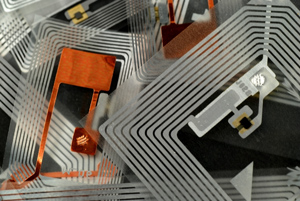Shop-floor monitoring goes high tech

Radio-frequency identification tags in combination with a sophisticated computer program are used to provide a snapshot of shop-floor conditions in manufacturing industries. © Albert Lozano/Hemera/Thinkstock
Individual operations on the shop floor of an industrial plant can be tracked using a sophisticated automated monitoring system that employs advanced mathematical techniques. To track work in progress, A*STAR scientists combined the popular radio-frequency identification (RFID) tags with rigorous computational processing of ‘discrete-event observers’1. This system will enable managers to make better, more timely decisions.
“The factory of the future will have zero defects, zero waste and zero accidents,” explains Jinwen Hu, who developed the system with colleagues from the A*STAR Singapore Institute of Manufacturing Technology. To eliminate the trifecta of defects, waste and accidents, monitoring systems need to extract timely, precise and, most importantly, usable information.
To design such a monitoring system, Hu and co-workers, through consultation with manufacturers, identified specific areas of concern as being machine breakdown, staff availability, machine status and work order flow.
Getting data from machinery was relatively simple — RFID tags are ubiquitous, being used in everything from shoplifting prevention technology to electronic road-toll collection. However, it was not so easy to figure out how to best use the collected data. “The biggest challenge was designing an efficient scheme that allowed computers to rapidly process the data and engineers to conveniently modify the monitoring rules,” notes Hu.
Accordingly, Hu and colleagues incorporated a discrete-event observer in their program. This observer constructs complex events — such as delays in delivery — by using probabilities derived from past plant operations to extrapolate ‘simple event’ raw data collected by scanning RFID tags.
In testing the system on the shop floor of a precision machining plant, a simple event occurred when a worker received a work order and scanned the associated RFID. Once the worker had completed the task, the order was passed to another operator and the RFID was rescanned. This process was repeated until the order had been completed.
A simple event can be in one of two states — incomplete or complete. By combining several simple events and extrapolating based on the probabilities of simple events transitioning from incomplete to complete, the discrete-event observer can assess whether delayed delivery is likely. Managers can then use this information to take appropriate action to ensure timely delivery.
Hu notes that there is a lot of scope for improving the system. For instance, integrating more data analysis functions into the system will provide shop-floor managers with more effective advice. The team also intends to customize the monitoring system to other manufacturing industries.
The A*STAR-affiliated researchers contributing to this research are from the Singapore Institute of Manufacturing Technology. More information about the group’s research can be found at the SIMTech Manufacturing Execution and Control Group webpage.
Reference
Hu, J., Lewis, F. L., Gan, O. P., Phua, G. H. & Aw, L. L. Discrete-event shop-floor monitoring system in RFID-enabled manufacturing. IEEE Transactions on Industrial Electronics 61, 7083–7091 (2014). | article
Media Contact
All latest news from the category: Power and Electrical Engineering
This topic covers issues related to energy generation, conversion, transportation and consumption and how the industry is addressing the challenge of energy efficiency in general.
innovations-report provides in-depth and informative reports and articles on subjects ranging from wind energy, fuel cell technology, solar energy, geothermal energy, petroleum, gas, nuclear engineering, alternative energy and energy efficiency to fusion, hydrogen and superconductor technologies.
Newest articles

First-of-its-kind study uses remote sensing to monitor plastic debris in rivers and lakes
Remote sensing creates a cost-effective solution to monitoring plastic pollution. A first-of-its-kind study from researchers at the University of Minnesota Twin Cities shows how remote sensing can help monitor and…

Laser-based artificial neuron mimics nerve cell functions at lightning speed
With a processing speed a billion times faster than nature, chip-based laser neuron could help advance AI tasks such as pattern recognition and sequence prediction. Researchers have developed a laser-based…

Optimising the processing of plastic waste
Just one look in the yellow bin reveals a colourful jumble of different types of plastic. However, the purer and more uniform plastic waste is, the easier it is to…



